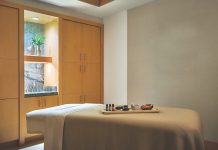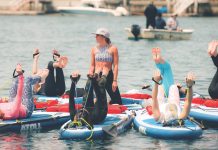Crystal Cove is home to 1,100 acres of pristine marine protected area, and Crystal Cove Alliance is hard at work to keep it that way while inspiring the next generation of ocean lovers.
By Linda Domingo | Photos by Jody Tiongco

Residents and visitors of Orange County are spoiled by the proximity of the ocean—more than 40 miles of OC coastline provide the backdrop for the endless commuters and tourists that speed down Pacific Coast Highway every day. Crystal Cove State Park is just a fraction of that network of beaches, but the rolling waves and sandy shores offers much more than a nice place to picnic or surf. The waters actually comprise a marine protected area, housing significant populations of plant and animal life, and the activities of the Crystal Cove Alliance (CCA) both on and offshore—from scientific research and education to public outreach—aid in the maintenance and preservation of the entire region. The industrious nonprofit organization doesn’t work alone, however. It has enlisted the help of top universities, researchers, schoolchildren and even fishermen in programs that are aimed at scientific discovery, managing the state park’s land and waters, and enriching the community.
Testing the Waters
Marine protected areas, designated regions in which human activity is restricted in the interest of protecting ocean ecosystems, were mandated by California State Legislature when it passed the Marine Life Protection Act. In January 2012, after much debate between conservation groups and fishing groups, the waters of Crystal Cove—1,100 acres, or about one-third of the state park—were dubbed a state marine conservation area, a level of marine protected area in which only certain types of fishing are allowed. “In the same way we protect and love [the land] here, offshore is an area in which we can now better protect kelp forests and reefs,” says Harry Helling, president and CEO of CCA. “Everything from nudibranchs to dolphins is protected.” In 2017, the state will reevaluate the marine protected area designations and their effectiveness in protecting marine life and habitats.
In the short time period that Crystal Cove has been a marine protected area, CCA has taken to the waters to explore ways in which to best manage and preserve the state park. Citizen science is the battle cry of the alliance—which means that some of the scientific research at the park is actually conducted by everyday, seemingly unqualified citizens. But with a little guidance, CCA has placed these citizens alongside researchers with years of education and experience in programs that allow them to collect data for environmentally relevant projects in fun, interesting and accessible ways.
One such program is the citizen science cruise, developed by Harry and CCA Education Manager Sue Magdziarz in collaboration with a group of schoolteachers. Middle and high school students board boats provided by Newport Landing Sportfishing—an unlikely partner, considering fishing groups and conservation groups had been at odds on the marine protected area debate—and essentially transform the boat into a floating science lab operated by the students.

“We come from very different sides of the spectrum … [but] we all want there to be a lot of fish in the ocean,” says Randi Woodbury, education coordinator at Newport Landing Sportfishing. “To be working together to really educate students about the importance of the conservation area, not only for the life that’s there now but the future of fishing, too, is really neat.”
Students collect plankton and water samples and operate cameras attached to fishing rods in order to observe kelp forests and their inhabitants. Being on a boat conducting research excites the students in a way that textbooks can’t, explains Dana Hills High School AP environmental science teacher Dolores Dang-Wright. Dolores was part of the pilot cruise program that CCA began developing in 2012, and she has taken multiple classes out on the water. The alliance hopes to organize about 50 cruises per year. “Hopefully we get some little scientists out of this,” Dolores says.
Although it’s a learning experience for the kids aboard, there’s another component: The data they collect will be sent to Donovan German, a researcher and assistant professor at UC Irvine. As part of his research, Donovan is studying fish populations, plankton diversity and water quality, and comparing the data collected inside and outside of marine protected areas. He hopes the research will eventually aid in evaluating the effectiveness of designated marine protected areas in protecting marine habitats and species.
According to Donovan, the cruises are the first instance of using citizen science in quantifying fish populations in the park, and they are providing another resource for researchers who have limited time, personnel and funding. “They’re going to have so many boats on the water collecting data that we otherwise wouldn’t be getting,” he says. “Not only are we getting valuable data on the effectiveness of the marine protected areas, but we’re getting citizens, non-scientists involved, who happen to be children. … It’s positive on so many different levels.”
Through the citizen science cruises and similar programs, CCA has placed citizen science at Crystal Cove at the crossroads of education, research and conservation. “If you go to a science center, you might be able to learn about a scientific concept, but if you go to Crystal Cove State Park, you could actually be the scientist, collecting data,” Sue explains.
Back on Dry Land

plastics on the beach at Crystal Cove
In addition to the cruises, significant research is also taking place in a humble-looking bungalow on the beach. Officially named the Park and Marine Research Facility, the building is most often referred to as simply Cottage 22 and is one of the district’s historic buildings. It was restored in 2008 with the help of donors including the Samueli Foundation, an anonymous foundation, Tricia Nichols and UC Irvine.
An important part of Harry’s role when he joined CCA in 2009 was to bring the cottage to life by attracting researchers and developing the citizen science programs that would effectively utilize the facility. Now, more than a dozen active research projects take place at Cottage 22 over the course of an average year.
One of the earlier projects that utilized Cottage 22 was a study on ocean acidification or what Harry refers to as the underwater evil twin of global warming, which could potentially result in the dissolution of coral reefs and other organisms. CCA brought high school students to the cottage to collect and analyze water samples, study the sizes of sea creatures and predict what the ocean’s acidity will be in the next 50 years. This data was then shared with UC Irvine and Stanford researchers.
“Ocean acidification is a significant issue … a global problem,” Harry explains. “We’re putting our students right at the edge of that research, and engaging them in the most current investigations of what’s impacting our oceans.”
Seasonal grunion run studies also take place at Cottage 22. Although common on Orange County beaches during their spawning season, grunion at Crystal Cove enjoy the added protection that the state park and marine protected area territory provide, which attracts grunion researchers like Karen Martin, professor of biology at Pepperdine University. Citizen scientists at grunion runs count and observe the habits of grunion, and CCA collects their data. Facing the same limitations as the scientists that conduct research at Crystal Cove, CCA uses the citizen scientist-collected data to help improve park management procedures, for example, distributing newly developed guidelines for driving on the beach, to ensure grunion eggs aren’t disturbed or affected.
While not evident to most people who pass by or even visit Crystal Cove on a daily basis, the innovative programs at this state park have caught the attention of those responsible for managing the state parks and their resources. “On a statewide basis, I would say Crystal Cove Alliance is a pioneer,” says Donna Pozzi, California State Parks chief of interpretation and education. Donna has invited Sue to give presentations on the citizen science programs at Crystal Cove to give other state parks the opportunity to learn how to make similar programs work. “[Scientists] tend to speak their own language, and they’re not as good at helping the public understand what they’re doing,” Donna explains. “Crystal Cove Alliance is playing a big role in helping that [interpretation] happen.”

The citizen science programs and research at Cottage 22 are just the beginning of a journey that Harry describes as never-ending. “This is a place where you’re always trying to improve … where you’re trying to understand the community needs and develop high-level programs to meet those needs,” he comments. “Crystal Cove Alliance is now in the business of inspiration. We’re designing science programs that are more than just content, more than just experience. They’re programs that are designed to inspire students to think differently about their world and their role in it … inspire them to think differently about how we understand the way the world works, considering pathways that would help us better understand and manage it.” NBM




